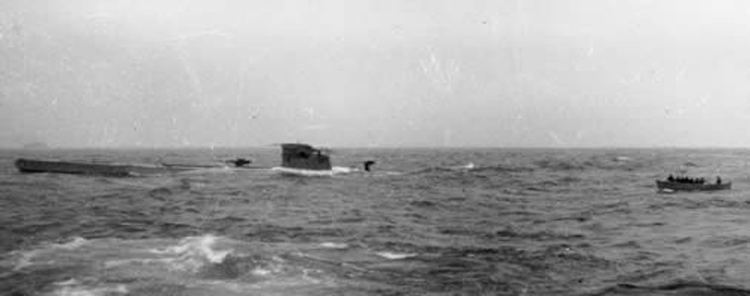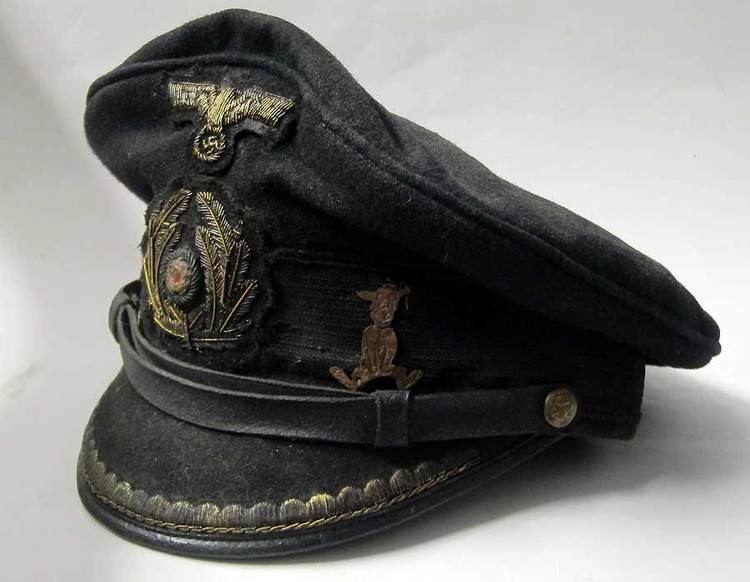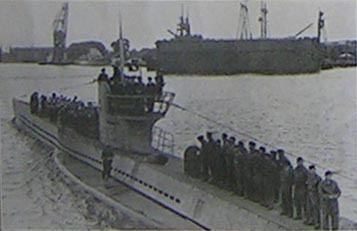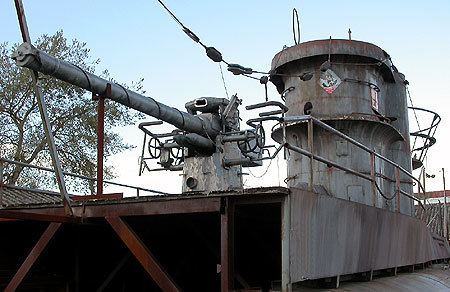Name U-110 Yard number 973 Launched 25 August 1940 Draft 4.7 m Commissioned 21 November 1940 | Ordered 24 May 1938 Laid down 1 February 1940 Construction started 1 February 1940 Length 76 m Beam 4.7 m | |
Fate Captured, 9 May 1941, sunk the following day Builders Deutsche Schiff- und Maschinenbau, AG Weser | ||
German submarine U-110 was a Type IXB U-boat of Nazi Germany's Kriegsmarine that operated during World War II. She was captured by the Royal Navy on 9 May 1941 and provided a number of secret cipher documents to the British. U-110's capture, later given the code name "Operation Primrose", was one of the biggest secrets of the war, remaining so for seven months. President Franklin D. Roosevelt was only told of the capture by Winston Churchill in January 1942.
Contents
- Design
- Service history
- 1st patrol
- 2nd patrol and capture
- Operation Primrose
- Modern day connections
- Wolfpacks
- Other captured U boats
- References

Design

German Type IXB submarines were slightly larger than the original German Type IX submarines, later designated IXA. U-110 had a displacement of 1,051 tonnes (1,034 long tons) when at the surface and 1,178 tonnes (1,159 long tons) while submerged. The U-boat had a total length of 76.50 m (251 ft 0 in), a pressure hull length of 58.75 m (192 ft 9 in), a beam of 6.76 m (22 ft 2 in), a height of 9.60 m (31 ft 6 in), and a draught of 4.70 m (15 ft 5 in). The submarine was powered by two MAN M 9 V 40/46 supercharged four-stroke, nine-cylinder diesel engines producing a total of 4,400 metric horsepower (3,240 kW; 4,340 shp) for use while surfaced, two Siemens-Schuckert 2 GU 345/34 double-acting electric motors producing a total of 1,000 metric horsepower (740 kW; 990 shp) for use while submerged. She had two shafts and two 1.92 m (6 ft) propellers. The boat was capable of operating at depths of up to 230 metres (750 ft).

The submarine had a maximum surface speed of 18.2 knots (33.7 km/h; 20.9 mph) and a maximum submerged speed of 7.3 knots (13.5 km/h; 8.4 mph). When submerged, the boat could operate for 64 nautical miles (119 km; 74 mi) at 4 knots (7.4 km/h; 4.6 mph); when surfaced, she could travel 12,000 nautical miles (22,000 km; 14,000 mi) at 10 knots (19 km/h; 12 mph). U-110 was fitted with six 53.3 cm (21 in) torpedo tubes (four fitted at the bow and two at the stern), 22 torpedoes, one 10.5 cm (4.13 in) SK C/32 naval gun, 180 rounds, and a 3.7 cm (1.5 in) as well as a 2 cm (0.79 in) anti-aircraft gun. The boat had a complement of forty-eight.
Service history
U-110's keel was laid down 1 February 1940 by DeSchiMAG AG Weser, of Bremen, Germany as yard number 973. She was launched on 25 August 1940 and commissioned on 21 November with Kapitänleutnant Fritz-Julius Lemp in command.

The boat was part of the 2nd U-boat Flotilla from her commissioning date until her loss. Lemp commanded U-110 for her entire career. In an earlier boat (U-30), he was responsible for the sinking of the passenger liner SS Athenia on the first day of the war. The circumstances were such that he was considered for court-martial. He continued, however, to be one of the most successful and rebellious commanders of his day.
1st patrol

U-110 set out on her first patrol from Kiel on 9 March 1941. Her route to the Atlantic Ocean took her through the gap between the Faroe and Shetland Islands. Her first victim was Erdona which she damaged south of Iceland on 16 March. She also damaged Siremalm on the 23rd. This ship only escaped after she was hit by a torpedo which failed to detonate, (although it left a large dent) and the U-boat's 105mm deck gun crew forgot to remove the tampion or plug in the muzzle before engaging their target. The resulting explosion on firing the first round wounded three men and compelled the boat to fire on the merchantman with the smaller 37 and 20 mm armament. Despite being hit, Siremalm successfully fled the scene, zig-zagging as she went.
U-110 arrived in Lorient on the French Atlantic coast on 29 March, having cut the patrol short due to damage from the exploding gun.
2nd patrol and capture
The boat departed Lorient on 15 April 1941. On the 27th she sank Henri Mory about 330 nautical miles (610 km; 380 mi) west northwest of Blasket Islands, Ireland.
Her next quarry were the ships of convoy OB 318 east of Cape Farewell (Greenland). She successfully attacked and sank Esmond and Bengore Head, but the escort vessels responded. The British corvette, HMS Aubretia, located the U-boat with ASDIC (sonar). Aubretia and British destroyer Broadway then proceeded to drop depth charges, forcing U-110 to surface.
Operation Primrose
U-110 survived the attack, but was seriously damaged. HMS Bulldog and Broadway remained in contact after Aubretia's last attack. Broadway shaped course to ram, but fired two depth charges beneath the U-boat instead, in an endeavour to make the crew abandon ship before scuttling her. Lemp announced "Last stop, everybody out", meaning "Abandon ship". As the crew turned out onto the U-boat's deck they came under fire from two attacking destroyers Bulldog and Broadway with casualties from gunfire and drowning. The British had believed that the German deck gun was to be used and ceased fire when they realised that the U-boat was being abandoned and the crew wanted to surrender.
Lemp realised that U-110 was not sinking and attempted to swim back to it to destroy the secret material, and was never seen again. A German eyewitness testified that he was shot in the water by a British sailor, but his fate is not confirmed. Including Lemp, 15 men were killed in the action, 32 were captured.
Bulldog's boarding party, led by sub-lieutenant David Balme, got onto U-110 and stripped it of everything portable, including her Kurzsignale code book and Enigma machine. William Stewart Pollock, a former radio operator in the Royal Navy and on loan to Bulldog, was on the second boat to board U-110. He retrieved the Enigma machine and books as they looked out of place in the radio room. U-110 was taken in tow back toward Britain, but sank en route to Scapa Flow.
The documents captured from U-110 helped Bletchley Park codebreakers solve Reservehandverfahren, a reserve German hand cipher.
Modern-day connections
The 2000 film U-571 was partially inspired by the capture of U-110.
In 2007, the submarine's chronometer was featured on the BBC programme Antiques Roadshow, from Alnwick Castle, in the possession of the grandson of the captain of the ship which captured her.
Wolfpacks
U-110 took part in one wolfpack, namely.
